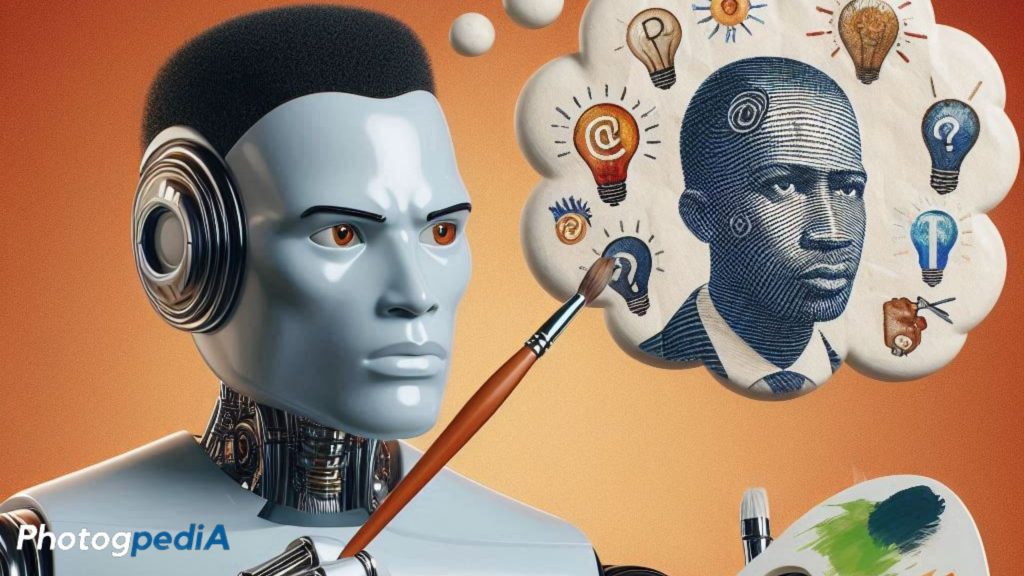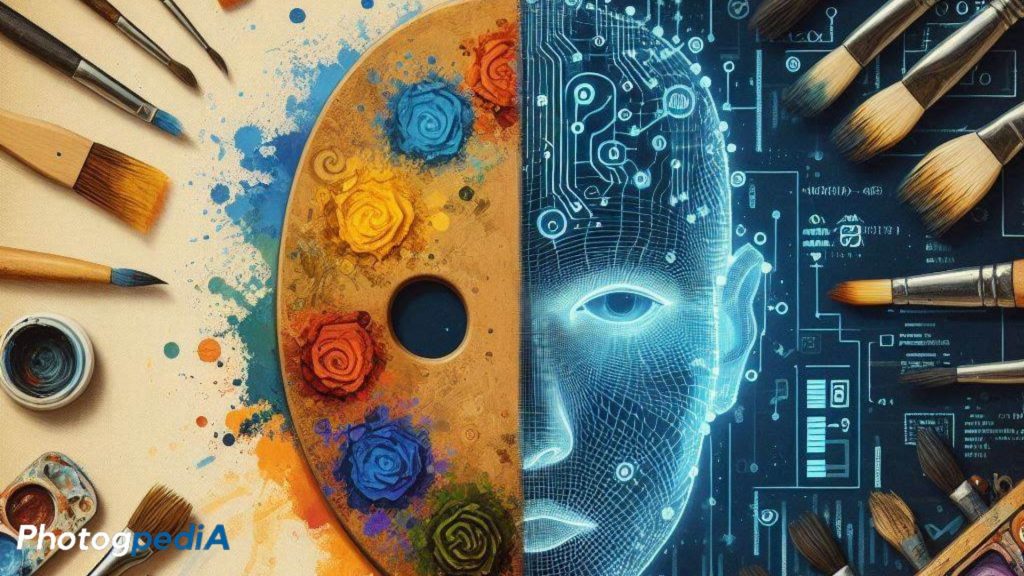AI art is an emerging field where artificial intelligence creates visual, auditory, or textual art. This fusion of technology and creativity is rapidly gaining popularity, bringing to light numerous ethical considerations in AI art. As an AI art enthusiast for the past two years, I’ve delved into countless AI art generators, constantly amazed by the spectrum of possibilities this new art form offers. However, with this excitement comes a growing awareness of the ethical complexities surrounding AI art.
Firstly, as AI art becomes more prevalent, understanding and addressing these ethical issues is crucial for fostering a fair and respectful art community. One of the most pressing concerns centers on the concept of authorship. Who truly deserves credit for an AI-generated artwork: the artist who prompts the AI, the programmer who built the algorithm, or the AI itself?
Firstly, a strong argument can be made for the artist’s role in guiding the AI’s creative direction through prompts and selections. On the other hand, the complex algorithms that translate these prompts into art represent a significant creative force. This ambiguity around authorship necessitates a clear definition of roles and proper attribution within the AI art world.
Table of Contents
Understanding AI Art
AI art refers to artwork created with the assistance of artificial intelligence. These pieces can range from paintings and music to poetry and digital illustrations, blurring the lines between human and machine creativity. AI algorithms analyze vast amounts of data, henceforth learning from existing artistic styles, techniques, and patterns to generate unique pieces of art.
How AI Creates Art
So, how does AI translate data into captivating works of art? AI uses machine learning, specifically neural networks, to analyze and interpret vast datasets of existing art. These datasets can encompass everything from classical paintings to contemporary street art. By analyzing this data, the AI learns to subsequently identify patterns, styles, and relationships between colors, shapes, and compositions. Imagine a vast library of artistic knowledge that the AI can access and learn from.
This knowledge allows the AI to not only mimic existing artistic styles but also create entirely new forms or even combine elements from different sources to produce innovative artworks. Artists can interact with these AI systems through prompts, guiding the AI’s creative direction and influencing the final piece.
Examples of AI Art in Various Mediums
The beauty of AI art lies in its versatility. AI art manifests in multiple forms, therefore pushing the boundaries of traditional artistic expression:
- Visual Art: AI-generated paintings and illustrations can range from photorealistic landscapes to abstract and surreal compositions.
- Music: AI can compose original music that can adapt to various genres, from classical symphonies to electronic dance music. Imagine an AI composing a piece that captures the essence of a specific genre while still maintaining its own unique voice.
- Literature: AI-written poetry and stories are emerging, pushing the boundaries of traditional writing. AI can thereupon generate new narratives, explore different literary styles, and even create interactive stories that adapt to the reader’s choices.
Historical Context
The Evolution of Art and Technology
The relationship between art and technology is a rich and ever-evolving narrative. From the invention of the camera, which forever changed how we capture and document the world, to the rise of digital art that opened doors to subsequently new creative avenues, technology has consistently served as a tool for artistic expression. AI art stands as the latest chapter in this ongoing relationship, pushing the boundaries of what is considered art and who is considered an artist.
This artistic evolution fueled by technology compels us to examine the history of AI art in more detail.
Key Milestones in AI Art Development
The journey of AI art boasts several significant milestones that mark its progress and growing sophistication. In the 1970s, Harold Cohen’s groundbreaking creation, AARON, emerged as a pioneering AI artist. AARON utilized a set of rules and algorithms to generate abstract compositions and paintings, paving the way for future exploration in AI-assisted artistic expression.
Fast forward to more recent times, and projects like DeepDream by Google showcase the remarkable advancements in AI art. DeepDream in particular employs deep learning algorithms to visualize the inner workings of neural networks, producing dreamlike and often mind-bending imagery. These milestones, along with countless others, illustrate the continuous development of AI art and its increasing potential to redefine artistic creation.
Authorship and Ownership

Who Owns AI-Generated Art?
One of the most intriguing and contentious aspects of AI art lies in the realm of authorship and ownership. Who truly owns an AI-generated artwork? Is it the programmer who meticulously crafted the algorithms that guide the AI’s creative process?
Perhaps it’s the user who provides the prompts and selections, influencing the final piece. Or, could the argument be made for the AI itself as the independent creator? This question has sparked heated debates within the art community and even legal battles as the legal frameworks surrounding AI art ownership are still under development.
The Role of the Programmer vs. The AI
The programmer undeniably plays a crucial role in the creation of AI art. They are the architects behind the complex algorithms that form the foundation of the AI’s creative capacity. These algorithms determine the range of artistic styles the AI can generate, the types of prompts it can respond to, and the overall framework within which the AI operates.
However, as AI becomes more sophisticated and autonomous, attributing authorship solely to the programmer becomes increasingly murkier. In some cases, the AI might surprise its creators with unexpected and innovative outputs, blurring the lines between human-designed parameters and the AI’s own creative spark.
Case Studies of Ownership Disputes
To illustrate the complexities surrounding ownership, let’s delve into a real-world case study. In 2018, an AI-generated portrait titled “Edmond de Belamy” created quite a stir when it sold for a staggering $432,500 at auction.
This sale sparked a multitude of questions about the rightful owner of the proceeds. Should the money go to the creators of the AI, the entity that essentially provided the tools for creation? Or perhaps ownership should be attributed to the AI itself? Some argue that the artwork is a product of its independent creative output? The auction house, as the facilitator of the sale, also entered the ownership equation. This case exemplifies the ongoing legal and ethical debates surrounding ownership in the realm of AI art.
Intellectual Property Issues
The murky waters of authorship naturally lead us to the complex topic of intellectual property (IP) in AI art. Here, copyright laws take center stage, and the picture they paint is far from clear.
Copyright Laws and AI Art
Current copyright laws were established with human creators in mind. They grant rights and protections to the individuals who generate original works of art. However, AI art presents a unique challenge. Can a machine be considered a legal author? This ambiguity leaves AI art in a legal gray area, eventually raising questions about ownership and the ability to enforce copyright protection.
Legal Challenges and Precedents
Legal systems worldwide are grappling with how to classify and protect AI art. Some jurisdictions have begun to address these challenges with landmark cases and evolving interpretations of copyright law.
For instance, the US Copyright Office has so far denied copyright protection to AI-generated works. They argue that they lack the human authorship requirement. However, this stance is being contested, and ongoing lawsuits may set new precedents in the future.
Protecting AI Art Under Current Laws
While current laws offer limited protection for AI art, there are still ways to navigate this complex space. In some cases, depending on the specific circumstances of creation, the human user who provides the prompts and edits the output might be able to claim copyright on the final artwork. However, this approach doesn’t fully address the rights of the programmer who built the AI or the potential creative contribution of the AI itself.
Ultimately, adjustments to intellectual property laws are needed to accommodate the unique nature of AI-generated works and ensure fair attribution and protection for all parties involved.
Impact on Human Artists
The emergence of AI art naturally raises concerns about its impact on human artists. Artists are the majority of people who are passionate about discussing the ethical considerations in AI art.
Economic Implications for Artists
One concern centers on the economic impact. AI art has the potential to disrupt the art market, potentially reducing opportunities for human artists. For instance, AI-generated art might become more affordable and readily available, impacting the demand for traditionally created pieces. However, the picture isn’t entirely bleak. AI art can also create new avenues for collaboration and innovation. This potentially leads to the creation of surprisingly new art forms and markets.
Changes in the Art Market
The art market is currently in a state of flux as it grapples with the implications and ethical considerations in AI art. Some collectors and galleries are embracing AI-generated works, explicitly recognizing their artistic merit and potential value. Others remain skeptical, questioning the artistic value of machine-made art and its place in the traditional art world.
Understanding these evolving dynamics is crucial for artists and art enthusiasts alike. Artists who can adapt and leverage AI as a tool can potentially gain a competitive edge. Equally, art enthusiasts can navigate the changing landscape with a more informed perspective.
Conclusion
The world of AI art is brimming with possibilities, both exciting and challenging. As AI continues to evolve, the ethical considerations in AI art, legal frameworks, and impact on human artists will undoubtedly continue to be debated and refined. One thing is certain: AI art is here to stay. It has the potential to redefine the very nature of artistic creation.
This article has merely scratched the surface of this fascinating topic. To delve deeper and explore the practical applications of AI art, we invite you to check out some of our other articles:
- AI Art Generators: A comprehensive guide to navigating the ever-growing landscape of AI art generation tools.
- Stable Diffusion Tips and Tricks: Unlock the full potential of Stable Diffusion, a popular AI art generation model, with these helpful tips and tricks.
- Img2Img AI Art Generation: Learn how to utilize Img2Img AI art generation to transform existing images into unique and creative works of art.
We hope you enjoyed this exploration of the ethical considerations in AI art. Stay tuned for further articles as we continue to explore the ever-evolving world of AI and its impact on the art world.
About the Author
Hi, I’m Mark – an amateur photographer that first started in 2020. I particularly capture action figures in miniature settings and dioramas. You can follow more of my work at the following social media channels:
- Instagram – iselandmarkventures
- Facebook – iselandmarkventures
- YouTube – The Iselandmarkventures

